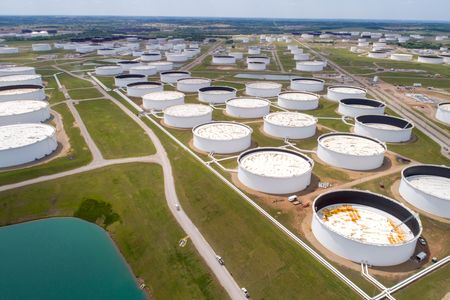By Stephanie Kelly
NEW YORK (Reuters) -Oil prices rose on Tuesday, recouping losses from the previous session, on optimism that China, the world’s second-largest oil consumer, could reopen from strict COVID curbs.
Brent crude for January delivery rose $1.84, or 2%%, to settle at $94.65 a barrel. The December contract expired on Monday at $94.83 a barrel, down 1%.
U.S. West Texas Intermediate (WTI) crude rose $1.84, or 2.1%, to $88.37 after falling 1.6% in the previous session.
An unverified note trending in social media, and tweeted by influential economist Hao Hong, said a “Reopening Committee” has been formed by Politburo Standing Member Wang Huning, and was reviewing overseas COVID data to assess various reopening scenarios, aiming to relax COVID rules in March, 2023. Hong Kong and China stocks jumped on the rumors.
A Chinese foreign ministry spokesman later said he was unaware of the situation.
“We’re getting a lot of signals in that direction and the market is responding very positively to that,” said Phil Flynn, an analyst at Price Futures Group.
The Brent and WTI benchmarks both registered monthly gains in October, their first since May, after the Organization of the Petroleum Exporting Countries (OPEC) and allies including Russia, a group known as OPEC+, cut their targeted output by 2 million barrels per day (bpd).
The OPEC+ cuts and record U.S. oil export data also support oil price fundamentals, said CMC Markets analyst Tina Teng.
Tamas Varga of oil broker PVM, meanwhile, said that dwindling oil supply, a possible halt to release of oil from the Strategic Petroleum Reserve (SPR) and reinvigorated oil demand growth could also send crude back above $100 a barrel.
An oil investment lag is sowing seeds for a future energy crisis, OPEC secretary General Haitham Al Ghais said on Tuesday.
OPEC raised its forecasts for world oil demand in the medium and longer term on Monday, saying that $12.1 trillion of investment is needed to meet this demand.
These bullish factors have offset demand concerns raised by COVID-19 curbs that lowered China’s factory activity in October and cut into its imports from Japan and South Korea.
U.S. crude oil stockpiles fell in the latest week, according to market sources citing American Petroleum Institute figures on Tuesday.
The API reported that crude stocks fell by about 6.5 million barrels for the week ended Oct. 28, they said. Gasoline inventories fell by about 2.6 million barrels, while distillate stocks rose by about 870,000 barrels, according to the sources, who spoke on condition of anonymity.
Eight analysts polled by Reuters estimated on average that crude inventories rose by about 400,000 barrels. U.S. government data is due on Wednesday.
(Reporting by Stephanie Kelly in New York; additional reporting by Rowena Edwards in London and Isabel Kua in SingaporeEditing by David Goodman, Angus MacSwan and David Gregorio)

